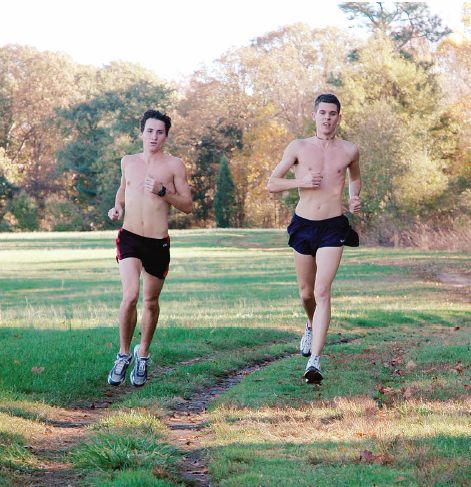
Hill training strengthens the legs for running better than any other activity I know. At the same time it can help you maximize your stride length, increase leg speed, and improve your ability to run hills in races. The hill training segments provide a gentle introduction to faster running, while improving your capacity to perform speedwork later in the program.
Beginners shouldn’t do hill training. If you’ve run several road races, you could run 1-4 hills (as mentioned below) on one of the short runs during the week. More experienced runners can follow the scheduled hill sessions on the schedules in this book.
The hill workout
• |
Walk for 5 minutes. |
• |
Warm-up: Jog and walk to a hill—about 10 minutes. Jog a minute and walk a minute (a longer warm-up is fine). |
• |
Do 4 acceleration-gliders. These are listed in the “Drills” chapter (don’t sprint). |
• |
Reverse the warm-up as your warm down. |
• |
Choose a hill with a gentle grade—steep hills often cause problems and bestow no benefit. |
• |
Walk to the top of the hill. Then step off the length of your hill segment by walking down from the top: |
• |
50 walking steps for those new to hill training |
• |
100-150 steps for those who have done very little speed work before |
• |
150-200 steps for those who have done speedwork, but not within the past 6 months |
• |
200-300 steps for those who have been doing regular speedwork |
Hill running form
• |
Start with a comfortable stride—fairly short. |
• |
As you go up the hill, shorten the stride. |
• |
Touch lightly with your feet. |
• |
Maintain a body posture that is perpendicular to the horizon (upright, not leaning forward or back). |
• |
Pick up the turnover of your feet as you go up and over the top. |
• |
Keep adjusting stride so that the leg muscles don’t tighten up—you want them as resilient as possible. |
• |
Walk more if needed before running the next hill. |
Hill training strengthens lower legs and improves running form
The incline of the hill forces your legs to work harder as you go up. The extra work up the incline and the faster turnover, builds strength. By taking an easy walk between the hills, and an easy day afterward, the lower leg muscles recover and rebuild, becoming stronger. Over several months, the improved strength allows you to support your body weight farther on your feet. An extended range of motion of the ankle and Achilles tendon results in a “bonus” extension of the foot—with no increase in effort. You will run faster without working harder. What a deal!
Running faster on hills in races
Once you train yourself to run with efficient hill form, you’ll run faster with increased turnover on the hill workouts. This prepares you to do the same in races. You won’t run quite as fast in a race as in your workouts. But through hill training you can run faster than you used to run up the same hill on a race course.
Race hill technique is the same as in workouts: keep shortening stride as you move up the hill. Monitor your respiration rate: don’t huff and puff more than you were doing on the flat. As runners improve their hill technique in races, they find that a shorter and quicker stride reduces effort while increasing speed—with no increase in breathing.
Note: on your long runs and easy running days, just jog up hills, don’t run faster up the hill. If your breathing is increasing on a hill, reduce effort and stride length until your respiration is as it was on the flat ground.
Downhill form
Biggest mistakes: too long a stride, bouncing too much
Even when your stride length is one or two inches too long, your downhill speed can get out of control. If you are bouncing more than an inch or two off the ground you run the risk of pounding your feet, having to use your quads to slow down (producing soreness) and creating hamstring soreness due to overstride. Best indicator of overstride is having tight hamstrings (big muscle behind your upper leg).
